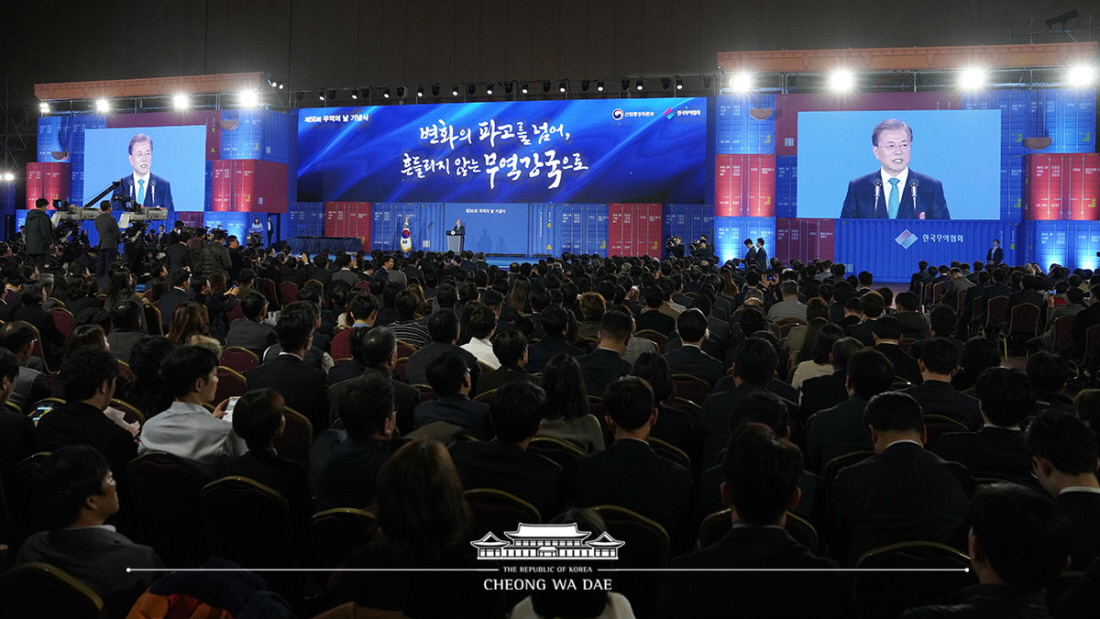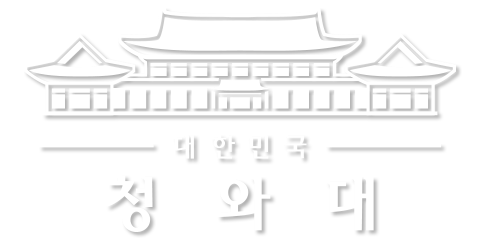이 웹사이트는 제19대 대통령 임기 종료에 따라 대통령기록관이 「대통령기록물 관리에 관한 법률」에 의해 이관받아 서비스하는 대통령기록물입니다. 자료의 열람만 가능하며 수정 · 추가 · 삭제는 불가능합니다.
다만, 「개인정보보호법」에 의하여 개인의 정보를 보호받기 원하시는 분은 관련 내용(요청자, 요청내용, 연락처, 글위치)을 대통령 웹기록물 담당자(044-211-2253)에게 요청해 주시면 신속히 검토하여 조치해 드리겠습니다. 감사합니다.
SPEECHES & REMARKS
BRIEFINGS

Fellow Koreans, distinguished international trading professionals,
Trade runs in the blood of Koreans.
Envoys from Korea’s ancient Goguryeo Kingdom, which had exchanges with Central Asia, are depicted in the Afrosiab mural in Samarkand, Uzbekistan. In China, merchants from our ancient Silla Kingdom established Sillabang – Korean enclaves – to engage in trade with the Tang Dynasty. During the Goryeo period, Byeoknando on the West Coast of the Korean Peninsula served as an international port, frequented by merchants from as far away as Arabia.
Koreans traded across a continent and ocean. When the country was open and actively trading, our economy and culture shined splendidly.
The 56th Trade Day today is an occasion for us to revisit the history of trade that has helped build the Republic of Korea’s economy and reaffirm its power to carve out Korea’s future as a bridging nation.
When the first Export Day was designated in 1964 to celebrate export volume breaking the US$100 million mark, Korea was a country that shipped such raw materials as iron ore and tungsten. By the time Export Day was renamed Trade Day in 1990, we had become an exporter of semiconductors, home appliances and automobiles.
We have unceasingly transformed ourselves to take on the challenges that come with entering global markets. While lowering trade barriers, we have developed new technologies and brought about innovations.
Trade is also what has helped us rise again at every critical juncture.
When Korea used loans from abroad to power its industrialization in the 1960s, exports served as a platform to repay the principal and secure new loans. This brought about the Miracle on the Hangang River. The strength that enabled us to overcome the 1997 foreign exchange crisis also came from an influx of foreign currency following an increase in exports.
Now we can also be optimistic about the future of our economy thanks to the robustness of trade.
In the midst of difficulties stemming from U.S.-China trade tensions and the global economic slowdown, all of the world’s top 10 exporters are seeing their exports dwindle, but Korea, this year, has achieved a US$1 trillion trade volume for the third consecutive year and marked a precious milestone: our 11th straight year with a trade surplus.
Moreover, among the countries posting US$1 trillion in trade, only three have registered manufacturing-based surplus: Korea, Germany and China. This fact points to our economy’s strong fundamentals.
We are also surmounting Japan’s export restrictions by uniting business leaders, scientists and engineers as well as the general public. By localizing the production of materials, parts and equipment and diversifying their import sources, we are actually turning this instead into an opportunity to enhance our industries’ competitiveness.
In this grave global economic situation, I am grateful to international trade professionals and citizens for safeguarding our economy while helping Korea maintain its status as a trading powerhouse.
International traders,
We are facing new challenges. We must take the lead in the era of the Fourth Industrial Revolution and ride out the violent waves of protectionism. While maintaining our flagship industries’ competitiveness, we have to secure new momentum for export growth.
Fortunately, our potential is being demonstrated everywhere.
Our mainstay industries are quickly recovering their competitiveness. Automobile exports to the United States, the European Union and ASEAN have increased evenly, and domestic shipbuilders have won more than 90 percent of global orders for LNG carriers this year, maintaining the No.1 spot in global orders for two years in a row.
New engines for export growth are also making rapid progress. Compared to last year, exports of electric and hydrogen-powered vehicles significantly increased – having more than doubled and tripled, respectively. The biohealth industry has seen its exports increase for nine years in a row. Exports of rechargeable batteries have risen for three years in a row, and we now export more food than home appliances.
The diversification of trade markets is also raising hopes. Exports to countries linked to the New Southern Policy, for the first time, accounted for over 20 percent of this year’s exports, and ASEAN is emerging as a key partner and Korea’s second largest destination for trade. Exports to the former Soviet Union, including Russia, also grew 24 percent year on year.
Small and medium-sized enterprises are making a noticeable leap forward as well. About 1,300 SMEs this year have started exporting for the first time, bringing the total number of SMEs exporting to around 90,000. SMEs will soon account for 20 percent of our total exports.
EMT Omega, developer of the world’s first dash cam that can be booted in about one second; HM International, an exporter of K-pop-related cultural content; i-SENS, a developer of a personal blood glucose monitoring device that has been exported to over 100 countries; and Ange, a manufacturer of baby products that has played a leading role in employing people with disabilities – these companies used their technology and competence to advance into global markets, and they represent the future of the Republic of Korea.
Our proud international traders,
An increasing number of companies are entering broader markets. We’re moving toward a new era when we grow and share profits together. We are ushering in an age when Korea – by sharpening its competitive edge through mutually beneficial cooperation between SMEs and large businesses – emerges as a trading powerhouse that cannot be shaken by the high waves of change.
Our people are well aware of your passion for crossing continents and oceans to blaze a trail through uncharted territory in order to conclude a single contract. The Government will join you with the same passion.
The ASEAN-ROK Commemorative Summit and the Mekong-ROK Summit served as venues to confirm the unlimited possibilities for cooperation. Starting from such areas as infrastructure, smart cities, the environment, finance and agriculture, the Republic of Korea will progress alongside ASEAN’s dreams.
In addition to the RCEP agreement, the world’s largest multilateral FTA, and the CEPA with Indonesia, we will lay a foundation for growth that links the New Southern Policy with the New Northern Policy by expanding bilateral FTAs with Malaysia, the Philippines, Russia and Uzbekistan.
By speeding up FTA negotiations with Mercosur, the South American common market, we will expand Korea’s FTA network – currently encompassing countries accounting for 77 percent of global GDP – to include countries producing 90 percent of global GDP by 2022.
Along with free trade, regulatory reform is essential to strengthen the competitiveness of new industries. We will develop the three new industries – system semiconductors, biohealth and future cars – as well as the cosmetics, rechargeable battery and food industries as future export engines. We will use regulatory sandboxes and special regulation-free zones to broaden the foundation that enables technological innovations and new products to succeed.
Fostering the materials, parts and equipment industries is the way to achieve technological self-sufficiency. Domestic companies have been expanding mutually beneficial cooperation while quickly adapting. Soulbrain, Hyosung Advanced Materials, Youngjin IND and Heesung Electronics not only localized the production of materials, parts and equipment but also increased their exports.
A bill to revise the special act to promote materials, parts and equipment industries passed the National Assembly, and relevant support measures and a system for implementation have been enacted into laws. The 2.1 trillion won in relevant funding earmarked for next year is also more than double this year’s, and 8.7 trillion won will be invested in technological development over the next five years. An increasing number of companies will advance to the global market, going beyond the localization of technology and production.
SMEs are the main players for future exports. Special loan guarantees for startups and SMEs will quadruple to 200 billion won next year, and trade financing will rise more than 30 percent to 8.2 trillion won to facilitate advances into emerging markets.
The Government will strengthen backing for Brand K marketing, which utilizes Hallyu to promote SME-produced goods in overseas exhibitions in order to help them penetrate foreign markets.
Fellow Koreans and international traders,
We have built today’s Republic of Korea through trade. Korea’s business environment was ranked fifth in the world and is considered the best among the G20 countries. Korea’s national competitiveness ranking has also risen for the third consecutive year, and the country is about to be listed among the top 10 most competitive countries in the world.
Our biggest strength lies in the trade that has brought about growth through openness and inclusiveness. Just as we have developed our economy thus far performing on a global scale, we will usher in a new era through trade as well.
Countries have territories, but trade is not confined by borders. When our ancestors expanded the domain of exchanges and trade to a continent and ocean, our country was able to advance in step with civilizations around the world.
The Government will always be with you so that our international traders can advance more robustly into every nook and cranny of the world with pride in our technology and products.
We will never stop our march until we see Korea become one of the world’s four biggest exporters by 2030. We will run vigorously with you toward a new future.
Thank you.



